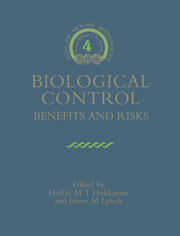Book contents
- Frontmatter
- Contents
- List of Contributors
- Series Preface
- Preface: Overview of Benefits and Risks of Biological Control Introductions
- Part I Biological Invasions
- Part II Classical Biocontrol
- Part III Augmentative Biocontrol
- Part IV Use of Genetically Modified Organisms
- 19 Assessing the Potential Benefits and Risks of Introducing Natural and Genetically Manipulated Bacteria for the Control of Soil-borne Root Diseases
- 20 Serodiagnostic Methods for Risk Assessment of Pseudomonas cepacia as a Biocontrol Agent
- 21 Benefits and Risks of Using Genetically Engineered Baculoviruses as Insecticides
- 22 Mathematical Modelling of Gene Exchange in Soil
- 23 Pest Resistance to Bacillus thuringiensis: Ecological Crop Assessment for Bt Gene Incorporation and Strategies of Management
- 24 An International Perspective for the Release of Genetically Engineered Organisms for Biological Control
- Part V Economics and Registration
- Index
20 - Serodiagnostic Methods for Risk Assessment of Pseudomonas cepacia as a Biocontrol Agent
Published online by Cambridge University Press: 07 May 2010
- Frontmatter
- Contents
- List of Contributors
- Series Preface
- Preface: Overview of Benefits and Risks of Biological Control Introductions
- Part I Biological Invasions
- Part II Classical Biocontrol
- Part III Augmentative Biocontrol
- Part IV Use of Genetically Modified Organisms
- 19 Assessing the Potential Benefits and Risks of Introducing Natural and Genetically Manipulated Bacteria for the Control of Soil-borne Root Diseases
- 20 Serodiagnostic Methods for Risk Assessment of Pseudomonas cepacia as a Biocontrol Agent
- 21 Benefits and Risks of Using Genetically Engineered Baculoviruses as Insecticides
- 22 Mathematical Modelling of Gene Exchange in Soil
- 23 Pest Resistance to Bacillus thuringiensis: Ecological Crop Assessment for Bt Gene Incorporation and Strategies of Management
- 24 An International Perspective for the Release of Genetically Engineered Organisms for Biological Control
- Part V Economics and Registration
- Index
Summary
Introduction
To develop successful biocontrol of plant diseases by the introduction of naturally occurring (see Défago et al., Chapter 12) or genetically engineered (see Dowling et al. Chapter 14) antagonistic pseudomonads, careful research is needed to assess risks. This includes viability and translocation of the microbes in soil ecosystems, transfer of genetic material to and from the indigenous soil microbial communities, effects of introductions on biochemical functions of the soil microflora and so on. The development of detection methods is important, not only for risk assessment of survival or dispersal of biocontrol microorganisms, such as genetically engineered microorganisms (GEMs) in soil, but also to evaluate the efficacy of biocontrol agents against plant diseases.
Pseudomonas cepacia Palleroni & Holmes, was initially described as a phytopathogen (Burkholder, 1950) as well as a saprophyte in soil (Sinsabaugh and Howard, 1975). It has been reported to provide biological control of certain soil-borne diseases, such as Fusarium-wilt of onion (Kawamoto and Lorbeer, 1976), damping-off of radish, Fusarium-wilt of tomato and Verticilliumwilt of eggplant (Homma et al., 1985). This bacterium is also known to produce various antibiotics, such as pyrrolnitrin (Elander et al., 1968; Janisiewicz and Roitman, 1988; Homma et al., 1989) and pseudane derivatives (Homma et al 1989), which are supposed to contribute to disease suppression. On the other hand, P. cepacia is extremely resistant to antimicrobial agents and is able to survive and multiply even in purified waters (Carson et at., 1973). In addition, it is known to be an opportunistic pathogen and has been described as a synonym for P. kingii and P. multivorans, and as aetiological agents of clinical infection (Ederer and Matsen, 1972; Randall, 1980).
- Type
- Chapter
- Information
- Biological ControlBenefits and Risks, pp. 217 - 222Publisher: Cambridge University PressPrint publication year: 1995



